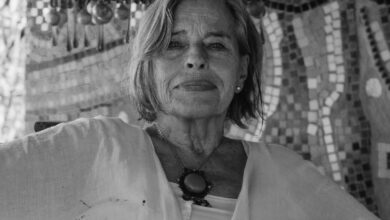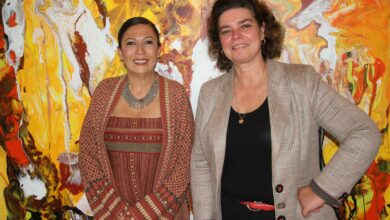The title of Damon Kowarsky’s exhibition at the Mashrabia Gallery – “In Visible Cities” – is a clever pun, but its relevance to the collection on display is in its literal meaning. This show is about a man existing in and looking at cities across the world. Kowarsky meticulously renders metropolises from Cairo and New York to his native city of Melbourne, Australia, with visits to Pakistan, Uzbekistan, and Syria along the way.
Kowarsky is a traveller, and has spent much of his artistic career drawing cities and villages, as well as people and artifacts, in North Africa, West Asia, Europe and the Middle East. He has what appears to be an obsessive interest in the forms of the city. But urban pull for Kowarsky lies neither in the hustle nor the bustle of the big city. He is attracted to the buildings more than the human element. In Kowarsky’s hand, even the most chaotic public intersection appears quiet and clean, an effect he compares to 19th century photography.
“I draw slowly, and if you are drawing a street scene, the people move too fast. Think about the early days of photography; you would see the Champs-Elysees without people because the exposure was half an hour long,” Kowarsky told Al-Masry Al-Youm.
This effect is striking in Kowarsky’s drawings of Cairo. The streets and rooftops are clean and silent. He captures the chaos of buildings, crammed together with Cairo’s tell-tale satellite dishes crowding every corner, without the chaos of people.
The hodge-podge of architecture in Cairo is part of what attracts Kowarsky to the city. “Everything is happening at once. You have 14th century Mamluk-style buildings next to Art Deco and a glass building that was built just two years ago. Some cities feel like museums frozen in one time period. Cairo does not feel like a museum. It’s always alive.”
Cairo is one of the cities in “In Visible Cities” with which Kowarsky has a long relationship. After university, while working as an archaeological illustrator at Dakhleh Oasis in the Western Desert, he would occasionally visit the city, and in 2003 and 2009, he was on residency at the Townhouse Gallery in downtown Cairo. But Kowarsky maintains the visual perspective of an outsider even when drawing his home city.
He explained, “I try to draw with as much concentration as I can, whether it is a place I have been all my life or a place I am new to. My drawings of my home might not be familiar to those who live there because they are taken from a particular perspective.”
The drawings currently on show are culled from Kowarsky’s urban-themed work of the past four years. When humans enter Kowarsky’s images, they take up half the frame. Often drawn from behind, they offer a near-silhouette, imposed over the distant image of a city. Kowarsky presents people and cities as equally large and distinct entities. People make their way into Kowarsky’s drawings as they make their way into his transient life: “When I have a large figure, it is a person or friend I have drawn for one or two hours and then inserted into the cityscape.”
While every different city in the drawings at Mashrabia has distinct and unique characteristics, Kowarsky creates formal continuity between disparate places. In his hands, the ancient Silk Road city of Khiva, in Uzbekistan, shares a blocky, angled outline with the skyscrapers of New York City. The repetition of forms creates a sense of universality in the cities of the world.
“It is these connections that interest me as much as the unique characteristics of each place," he said.
But in Kowarsky’s blues and greys, the traveller’s gaze sometimes becomes a flattening one, in which so many cities are seen that they begin to blend together.
While Kowarsky’s drawings are concentrated and still, the product of long sits in various locations, they nonetheless maintain some aspect of a scene glanced at from a train or airplane window. They give the impression of an artist looking at the world from a distance, never getting too personal, never becoming too connected to any one place.
Damon Kowarsky’s drawings and etchings are on display at the Mashrabia Gallery until 2 July.
Mashrabia Gallery, 8 Champollion Street, Downtown, Cairo
The gallery is open daily from 11 am to 8 pm except Fridays.




